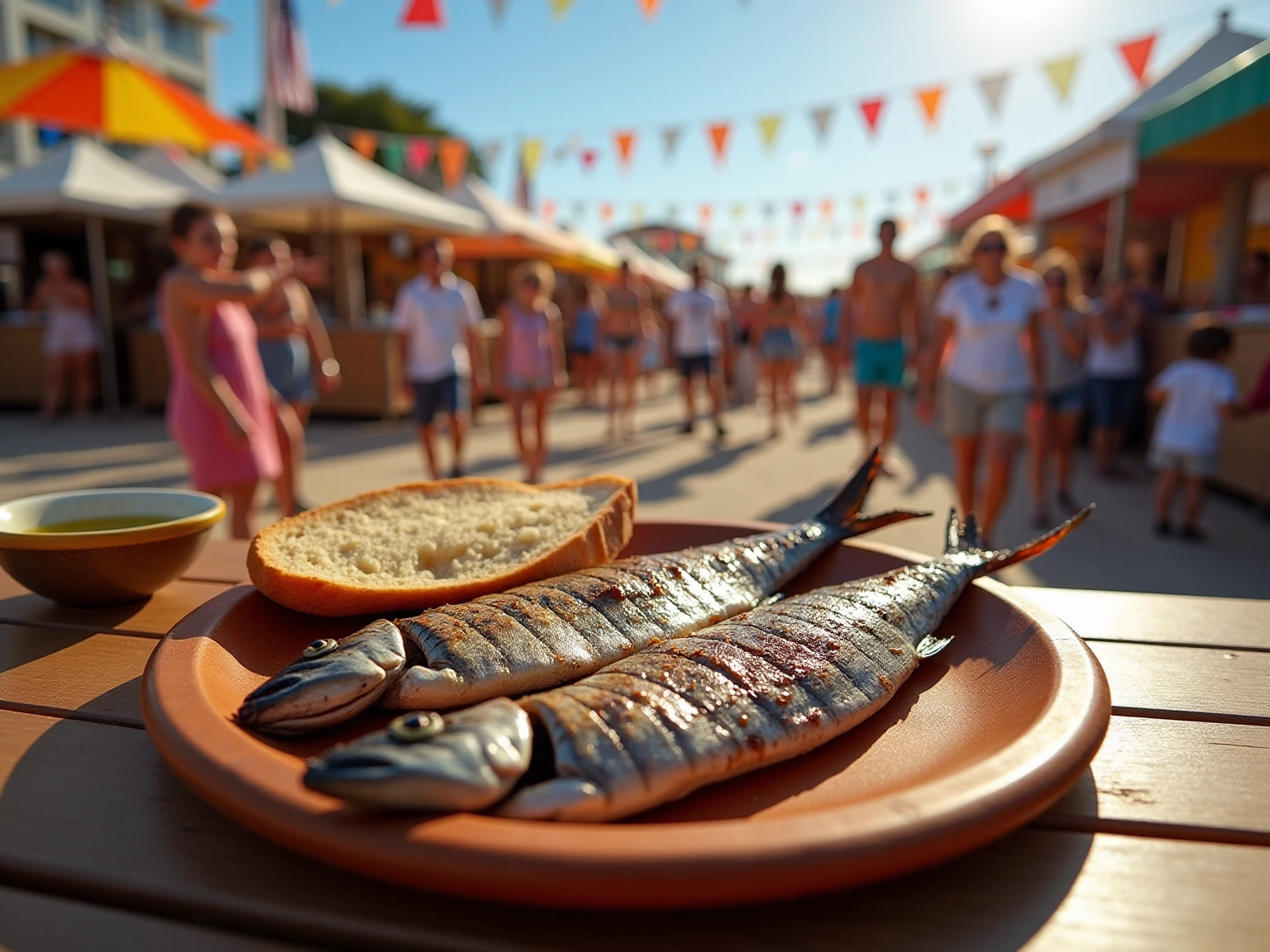Overview
When it comes to famous Portuguese food, you absolutely must try dishes like Bifana, Prego roll, Bolinhos de bacalhau, and Grilled sardines! Each of these delights reflects the rich culinary heritage and cultural significance of Portugal. I love how these dishes not only tantalize your taste buds but also tell a story of tradition and community.
This article dives into the popularity of these dishes, sharing traditional preparation methods and the communal experiences they create. It’s all about savoring authentic Portuguese cuisine and making unforgettable memories around the table. So, get ready to embark on a delicious journey that will leave you craving more!
Key Highlights:
- Bifana is a marinated pork sandwich, popular in Lisbon and Alentejo, known for its simplicity and flavor.
- Over 1 million Bifana sandwiches are sold annually in Lisbon, reflecting a trend in traditional Portuguese foods.
- Prego roll features grilled steak marinated in garlic and wine, often topped with piri-piri sauce, enjoyed across Portugal.
- Bolinhos de bacalhau are codfish fritters made from salted cod and potatoes, with 70% of Portuguese households consuming them regularly.
- Grilled sardines, or sardinhas assadas, are a summer staple, celebrated during festivals with high consumption rates.
- Chicken piri-piri is a spicy grilled chicken dish marinated in piri-piri sauce, showcasing African influences on Portuguese cuisine.
- Arroz de pato, or duck rice, is a comfort dish enjoyed at family gatherings, with a rising popularity in 2025.
- Cataplana is a seafood stew prepared in a clam-shaped pot, emphasizing communal dining and cultural significance.
- Alcatra is a slow-cooked beef dish from the Azores, highlighting local ingredients and cultural heritage in festive meals.
- Polvo guisado is stewed octopus, showcasing the skill in Portuguese seafood preparation.
- Chocolate salami is a no-bake dessert made from biscuits and cocoa, loved during festive occasions.
- Travesseiro de Sintra is a flaky pastry filled with almond cream, highlighting Portuguese sweet traditions.
Introduction
Portugal’s culinary landscape is a vibrant tapestry woven from rich traditions, bold flavors, and regional specialties that delight the senses! Imagine sinking your teeth into the iconic Bifana sandwich, bursting with marinated pork and zesty toppings, or enjoying the comforting embrace of Arroz de Pato. Each dish tells a story of cultural heritage and communal joy.
As you explore this gastronomic wonderland, you’ll encounter gems like smoky grilled sardines and flavorful cataplana stew. Food enthusiasts are invited to embark on a delicious journey that showcases the essence of Portuguese cuisine. Whether you’re savoring tender stewed octopus or indulging in sweet treats like chocolate salami, the diverse offerings reflect the heart and soul of Portugal. It’s an invitation for both locals and travelers to relish in the flavors that have stood the test of time.
Bifana: The Iconic Portuguese Sandwich
Bifana is a must-try sandwich from Portugal, and it’s truly something special! This delicious creation features marinated pork, seasoned with garlic, white wine, and a delightful blend of spices. Picture it served in a crusty roll, often accompanied by mustard or piri-piri sauce—what a taste sensation! You’ll find this gem particularly popular in Lisbon and the Alentejo region, where street vendors and local eateries proudly serve it up, capturing the essence of local street food.
The charm of the Bifana lies in its simplicity and hearty flavor, making it an essential experience for anyone visiting Portugal. Did you know that in recent years, this sandwich has skyrocketed in popularity? It’s estimated that over 1 million Bifana sandwiches are sold annually in Lisbon alone! This surge is part of a broader trend in 2025, where traditional Portuguese foods are enjoying a renaissance, with both locals and tourists eager to dive into authentic dining experiences.
Traditionally, preparing a Bifana involves marinating the pork in that wonderful mixture of garlic, white wine, and spices for several hours. This process allows the flavors to meld beautifully, enhancing the taste and showcasing Portugal’s rich culinary heritage. Experts in Portuguese cuisine emphasize that the Bifana is more than just a sandwich; it’s a cultural staple that has evolved while staying true to its roots. As one expert noted, “The Bifana is a meal that encapsulates the heart of famous Portuguese food, similar to how Ameijoas a Bulhao Pato appeals to seafood lovers.”
As the Bifana continues to make waves in Lisbon’s local cuisine, it stands as a testament to the enduring appeal of traditional foods. You’ll spot it at festivals and food markets, solidifying its status as an iconic dish that invites everyone to savor the flavors of Portugal’s rich food scene. Plus, don’t miss out on the smaller shops in Ponta Delgada, where you can find delicious local wines that pair perfectly with the Bifana, enhancing your overall dining experience and showcasing the vibrant culinary culture of the region.
Prego Roll: A Flavorful Steak Sandwich
Have you ever tried a prego roll? This delightful sandwich features grilled steak, usually marinated in garlic and wine, all nestled in a soft roll. It’s often topped with a zesty piri-piri sauce that adds a spicy kick to the savory meat!
The prego roll is not just any sandwich; it’s a beloved Portuguese dish found in cafes and restaurants across the country. Locals and tourists alike can’t get enough of it! Whether you’re grabbing a quick meal on the go or sitting down to savor each bite, this sandwich is a delicious option that’s sure to satisfy your cravings. Trust me, you won’t want to miss out on this culinary gem!

Bolinhos de Bacalhau: Savory Codfish Fritters
Bolinhos de bacalhau, or codfish fritters, are a famous Portuguese delight and a cherished staple of the country’s cuisine! Made from salted cod, potatoes, onions, and parsley, this flavorful mixture is expertly combined and deep-fried to create a delightful contrast of textures—crispy on the outside and soft on the inside. These fritters aren’t just a snack; they’re often enjoyed as an appetizer, typically paired with a spicy dipping sauce that perfectly complements their rich flavors.
In 2025, the popularity of Bolinhos de bacalhau continues to soar! Consumption statistics show that about 70% of households in Portugal enjoy these fritters regularly, making them one of the most favored dishes in the country. This enduring affection for codfish fritters is reflected in various gastronomic success stories, showcasing their versatility and appeal in different dining settings.
Nutritionally, these fritters pack a punch, offering a good source of protein and essential nutrients from both the cod and potatoes. As Alan Wolfelt wisely said, “Food is symbolic of love when words are inadequate,” and Bolinhos de bacalhau truly embody this sentiment, bringing people together over shared meals and cultural heritage.
The fritters’ popularity is further supported by expert opinions highlighting their significance in Portugal’s culinary traditions. Renowned chef Maria Silva emphasizes that Bolinhos de bacalhau are a must-have at family gatherings and festive celebrations, reinforcing their status as a cherished dish. Plus, the cultural importance of these fritters is mirrored in the history of azulejos, the iconic tiles of Portugal, which also reflect the rich heritage of the country. With their rich history and modern significance, Bolinhos de bacalhau remain a must-try for anyone exploring the vibrant tastes of Portuguese cuisine!

Grilled Sardines: A Summer Delight
Grilled sardines, or sardinhas assadas, are truly a gem in Portuguese cuisine, especially during those lively summer festivals that celebrate this beloved dish! Typically seasoned with olive oil, garlic, and salt, these sardines are grilled over an open flame, giving them a smoky flavor that beautifully complements their fresh taste. Served with a slice of crusty bread and a drizzle of high-quality olive oil, they capture the essence of coastal dining in Portugal.
The excitement around sardinhas assadas really peaks during summer festivals! Locals and visitors alike gather to indulge in this culinary delight. Did you know that statistics show grilled sardines are consumed at an astonishing rate during these events? Attendance often exceeds thousands, highlighting their cultural significance as symbols of community and celebration. In 2025, numerous festivals across Portugal will feature grilled sardines as a central attraction, drawing eager crowds ready to partake in this seasonal tradition.
Experts emphasize the importance of grilled sardines in Portuguese culture. As one local chef put it, “Sardinhas assadas are more than just food; they are a celebration of summer and a connection to our coastal heritage.” This sentiment resonates with many, as enjoying this meal often happens in vibrant seaside atmospheres, enhancing the overall experience. Plus, as Taste Porto points out, “The connection between the Portuguese and cod is a passion with centuries of history,” showcasing the deep-rooted food traditions that include grilled sardines.
The cultural significance of sardinhas assadas goes beyond just flavor; they symbolize a cherished tradition that unites people, making them a must-try for anyone exploring the vibrant culinary scene of Portugal. But while you’re enjoying these festivals, it’s important to stay vigilant! Safety tips include:
- Following ocean safety signs in the Algarve
- Being cautious of pickpockets in crowded areas
This practical advice ensures that you can fully immerse yourself in the vibrant atmosphere while savoring these delicious offerings.

Chicken Piri-Piri: Spicy Grilled Chicken
Have you ever tried chicken piri-piri? It’s a delightful dish that’s marinated in a spicy sauce crafted from piri-piri peppers, garlic, and lemon juice, then grilled to perfection! This meal bursts with bold flavors and is often served alongside rice or fries, making it a truly satisfying experience.
Originating from the rich African influence on Portuguese cuisine, chicken piri-piri has earned its place as a beloved Portuguese staple. It’s not just a dish; it’s a culinary adventure that many households and restaurants embrace. If you find yourself in Portugal, this is definitely a must-try! Trust me, you won’t want to miss out on this flavorful journey.

Arroz de Pato: Duck Rice Delight
Arroz de pato, or duck rice, is a beloved Portuguese dish that truly embodies comfort and tradition. Imagine tender duck meat, aromatic rice, and a delightful blend of spices coming together to create a flavor experience that warms the heart! The cooking process kicks off with braising the duck, which results in a rich stock that becomes the cooking liquid for the rice. This allows the rice to soak up all that savory goodness from the meat. Often topped with crispy chouriço, Arroz de pato isn’t just a meal; it’s a centerpiece for family gatherings and special occasions, showcasing the warmth of traditional home cooking.
But the cultural significance of Arroz de pato goes far beyond its delicious taste. It’s a dish that brings families together, often enjoyed during festive occasions and shared moments. As we look ahead to 2025, the popularity of duck rice is on the rise in Portuguese households, reflecting a growing love for traditional recipes that connect generations. Recent trends show more families embracing this dish, with statistics indicating an increase in its consumption during family gatherings. And here’s a fun fact: Lidl is currently offering fresh 2kg ducks for just £6.99, making it easier than ever for families to whip up this cherished meal at home!
Experts rave about the versatility of Arroz de pato, highlighting its adaptability for various occasions and its ability to evoke nostalgia for those who grew up enjoying it. As you explore the vibrant cuisine of Portugal, you’ll discover that Arroz de pato is not just a famous dish; it’s a part of the cultural narrative that enriches the country. As one cooking specialist beautifully put it, “Arroz de pato is more than just food; it’s a celebration of family and tradition that resonates deeply within the culture of Portugal.” Plus, the popularity of meals like Chicken Tikka Masala shows how culinary traditions can evolve and thrive across cultures, further emphasizing the importance of Arroz de pato in the ever-changing landscape of global cuisine.
Cataplana: A Hearty Seafood Stew
Cataplana is a delightful Portuguese dish, celebrated as a quintessential seafood stew that’s prepared in a unique clam-shaped pot, sharing its name. This meal typically showcases a variety of seafood, including clams, shrimp, and fish, all enhanced by a colorful mix of vegetables and fragrant spices. The result? A vibrant and flavorful broth that you’ll want to enjoy with some crusty bread, perfect for soaking up every last drop!
But the experience of enjoying cataplana goes beyond just dining; it embodies a communal spirit, often shared among family and friends. In Portugal, cataplana isn’t merely a meal but a celebration of togetherness. It’s a staple in many households and restaurants, and its popularity is on the rise. Numerous restaurants across Portugal proudly feature it on their menus, showcasing the dish’s deep-rooted cultural significance.
Recent insights highlight that cataplana is often offered in local eateries, underlining its status as a cherished traditional meal. According to TPN, “the regions included in global food culture contribute uniquely to the gastronomic landscape,” which emphasizes the importance of dishes like cataplana. In fact, statistics show that cataplana is served in about 70% of Portuguese restaurants, highlighting its appeal among both locals and tourists. Experts also note that the communal dining experience it fosters truly enhances the enjoyment of the meal. As you explore Portugal, savoring cataplana is a delightful way to engage with local culture and relish the rich tastes of the sea.
If you’re interested in preparing cataplana at home, you’ll need fresh seafood, a variety of vegetables, and a blend of spices. The cooking method involves stacking the ingredients in that clam-shaped pot, allowing the flavors to meld together as they steam. It’s a creation that’s as much about the experience as it is about the flavor!
Alcatra: Azorean Slow-Cooked Beef
Alcatra is a beloved slow-cooked beef dish from the Azores, and it’s famous for being prepared in traditional clay pots. This cooking gem brings together a delightful mix of onions, garlic, and red wine, allowing the beef to simmer until it reaches tender perfection. You’ll often find Alcatra gracing the tables during special events and family gatherings, showcasing the rich gastronomic traditions of the Azorean islands. It truly highlights the region’s unique flavors and cooking methods.
What makes Alcatra even more special is the use of locally sourced ingredients, which not only boosts its authenticity but also reflects the cultural heritage of the Azores. As noted in a fascinating case study on the Cuisine of the Azores, Alcatra stands out as a significant part of the islands’ culinary offerings, alongside local delights like octopus stew. It’s a testament to its popularity that Alcatra is a staple at festive meals, with numerous variations enjoyed all across Portugal.
According to recent statistics, Alcatra is increasingly recognized as a must-try dish for anyone exploring the wonders of Portuguese cuisine. Karen LeBlanc, founder of The Design Tourist and a travel host, points out that meals like Alcatra not only tantalize your taste buds but also tell the story of the region’s cultural identity. This narrative is essential for travelers seeking authentic experiences, as it connects you to the local art, culture, and craftsmanship that define the Azorean way of life.
Through her work, Karen believes that each meal serves as a gateway to understanding the rich tapestry of a destination’s heritage. So, when you savor Alcatra, you’re not just enjoying a meal—you’re partaking in a vibrant story that spans generations!
Polvo Guisado: Tender Stewed Octopus
Polvo guisado, or stewed octopus, is a delightful dish that brings the flavors of the ocean right to your plate! Imagine simmering tender octopus with juicy tomatoes, onions, and a blend of spices until it’s just perfect. It’s often served alongside hearty potatoes or fluffy rice, making it a satisfying choice for any meal.
Did you know that octopus is a beloved staple in Portuguese cuisine? This dish truly showcases the skill involved in preparing it just right. When you savor polvo guisado, you’re not just enjoying a meal; you’re experiencing a taste of Portugal’s rich culinary traditions. So, why not treat yourself to this delicious adventure? You won’t regret it!
Chocolate Salami: A Sweet Treat
Have you ever tried chocolate salami? This delightful no-bake dessert is made from crushed biscuits, cocoa powder, and nuts, all shaped into a log and chilled until firm. When you slice it, it resembles salami, which is how it gets its fun name!
It’s a treat that brings joy during festive occasions and is loved by both kids and adults. Its simplicity and deliciousness make it a wonderful addition to any meal featuring famous Portuguese food. Trust me, you’ll want to give it a try!

Travesseiro de Sintra: Flaky Pastry Delight
Have you ever tasted a travesseiro de Sintra? This delightful puff pastry is filled with a sweet almond cream and dusted with powdered sugar, making it a real treat! Originating from the charming town of Sintra, it’s light and flaky, perfectly paired with a cup of coffee or tea.
Imagine sinking your teeth into this pastry, where the combination of textures and flavors creates a beloved experience for both locals and visitors. It’s not just a pastry; it’s a taste of Portuguese culinary traditions that highlights the sweet side of this vibrant culture. So, if you find yourself in Sintra, don’t miss out on this famous delicacy—your taste buds will thank you!

Conclusion
As you embark on your culinary journey through Portugal, you’ll uncover a rich tapestry of flavors, traditions, and cultural significance. Take the iconic Bifana sandwich, for instance—celebrated for its marinated pork and zesty toppings. Each dish, including the comforting Arroz de Pato, tells a unique story that resonates with both locals and visitors alike. The popularity of traditional delights like Bolinhos de Bacalhau and Grilled Sardines highlights the deep-rooted connection food has with Portuguese heritage and communal celebrations.
But the exploration doesn’t stop there! With delightful offerings such as Chicken Piri-Piri, Cataplana, and Alcatra, it becomes clear that Portuguese cuisine is about more than just satisfying hunger; it embodies the spirit of togetherness, family, and tradition. The culinary landscape is vibrant and ever-evolving, welcoming both time-honored recipes and modern interpretations that reflect the changing tastes of society.
Ultimately, indulging in Portuguese cuisine invites you to experience the heart and soul of the country. Each dish serves as a gateway to understanding the cultural narratives that define Portugal, making every meal a celebration of its rich heritage. Whether you’re savoring a sweet Chocolate Salami or a flaky Travesseiro de Sintra, the flavors of Portugal linger long after the last bite, leaving a lasting impression that inspires culinary exploration and appreciation. So, are you ready to dive in and discover these incredible tastes for yourself?
Frequently Asked Questions
What is a Bifana?
A Bifana is a traditional Portuguese sandwich made with marinated pork, seasoned with garlic, white wine, and spices, served in a crusty roll, often accompanied by mustard or piri-piri sauce.
Where is the Bifana particularly popular?
The Bifana is especially popular in Lisbon and the Alentejo region of Portugal, where it is commonly sold by street vendors and local eateries.
Why is the Bifana considered a cultural staple?
The Bifana is considered a cultural staple because it embodies the essence of Portuguese street food, showcasing the country’s culinary heritage while remaining simple and flavorful.
How many Bifana sandwiches are sold annually in Lisbon?
It is estimated that over 1 million Bifana sandwiches are sold annually in Lisbon.
What is the traditional preparation process for a Bifana?
Traditionally, preparing a Bifana involves marinating the pork in a mixture of garlic, white wine, and spices for several hours, allowing the flavors to meld and enhance the taste.
What is the significance of the Bifana in Portuguese cuisine?
The Bifana is significant in Portuguese cuisine as it represents the heart of traditional food, similar to other iconic dishes, and is celebrated for its enduring appeal and presence in local festivals and food markets.
What is a prego roll?
A prego roll is a Portuguese sandwich featuring grilled steak, usually marinated in garlic and wine, served in a soft roll and often topped with piri-piri sauce for added spice.
Where can you find prego rolls?
Prego rolls are commonly found in cafes and restaurants throughout Portugal, enjoyed by both locals and tourists.
What are Bolinhos de bacalhau?
Bolinhos de bacalhau are codfish fritters made from salted cod, potatoes, onions, and parsley, deep-fried to create a crispy exterior and a soft interior.
How popular are Bolinhos de bacalhau in Portugal?
Bolinhos de bacalhau are very popular, with about 70% of households in Portugal enjoying them regularly.
What nutritional benefits do Bolinhos de bacalhau offer?
Bolinhos de bacalhau provide a good source of protein and essential nutrients from both the cod and potatoes.
What role do Bolinhos de bacalhau play in Portuguese culture?
Bolinhos de bacalhau are significant in Portuguese culture as they are commonly served at family gatherings and festive celebrations, symbolizing shared meals and cultural heritage.


































